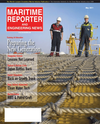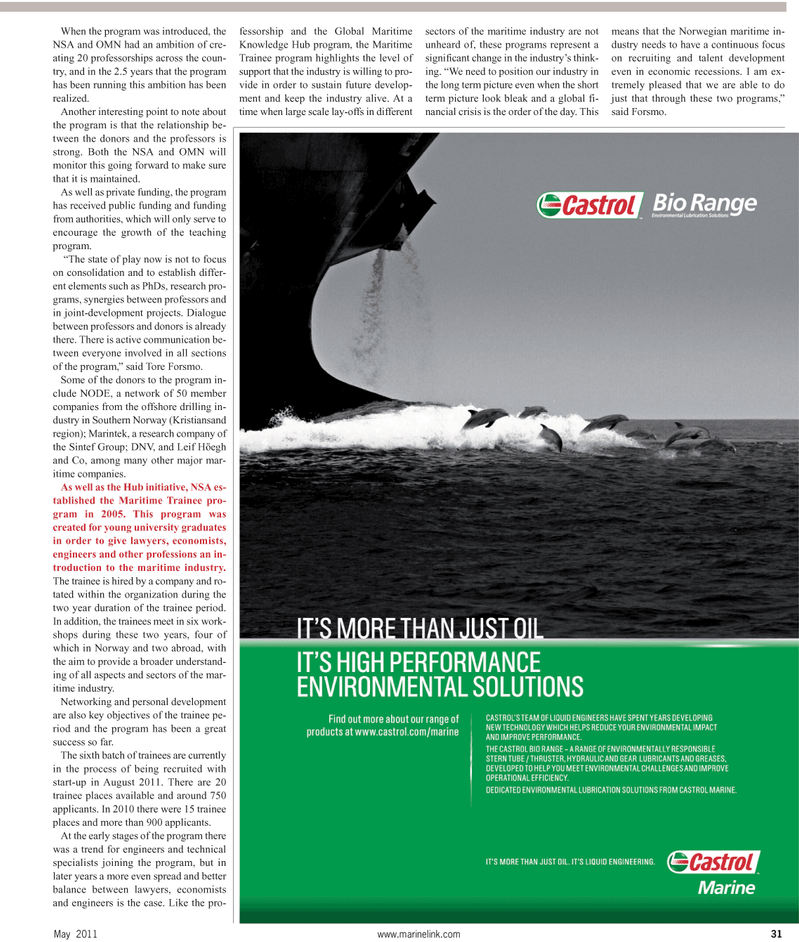
Page 31: of Maritime Reporter Magazine (May 2011)
Training & Education Edition
Read this page in Pdf, Flash or Html5 edition of May 2011 Maritime Reporter Magazine
May 2011 www.marinelink.com 31
When the program was introduced, the
NSA and OMN had an ambition of cre- ating 20 professorships across the coun- try, and in the 2.5 years that the program has been running this ambition has been realized.
Another interesting point to note about the program is that the relationship be- tween the donors and the professors is strong. Both the NSA and OMN will monitor this going forward to make sure that it is maintained.
As well as private funding, the program has received public funding and funding from authorities, which will only serve to encourage the growth of the teaching program. “The state of play now is not to focus on consolidation and to establish differ- ent elements such as PhDs, research pro- grams, synergies between professors and in joint-development projects. Dialogue between professors and donors is already there. There is active communication be- tween everyone involved in all sections of the program,” said Tore Forsmo.
Some of the donors to the program in- clude NODE, a network of 50 member companies from the offshore drilling in- dustry in Southern Norway (Kristiansand region); Marintek, a research company of the Sintef Group; DNV, and Leif Höegh and Co, among many other major mar- itime companies.
As well as the Hub initiative, NSA es- tablished the Maritime Trainee pro- gram in 2005. This program was created for young university graduates in order to give lawyers, economists, engineers and other professions an in- troduction to the maritime industry.
The trainee is hired by a company and ro- tated within the organization during the two year duration of the trainee period.
In addition, the trainees meet in six work- shops during these two years, four of which in Norway and two abroad, with the aim to provide a broader understand- ing of all aspects and sectors of the mar- itime industry.
Networking and personal development are also key objectives of the trainee pe- riod and the program has been a great success so far.
The sixth batch of trainees are currently in the process of being recruited with start-up in August 2011. There are 20 trainee places available and around 750 applicants. In 2010 there were 15 trainee places and more than 900 applicants.
At the early stages of the program there was a trend for engineers and technical specialists joining the program, but in later years a more even spread and better balance between lawyers, economists and engineers is the case. Like the pro- fessorship and the Global Maritime
Knowledge Hub program, the Maritime
Trainee program highlights the level of support that the industry is willing to pro- vide in order to sustain future develop- ment and keep the industry alive. At a time when large scale lay-offs in different sectors of the maritime industry are not unheard of, these programs represent a significant change in the industry’s think- ing. “We need to position our industry in the long term picture even when the short term picture look bleak and a global fi- nancial crisis is the order of the day. This means that the Norwegian maritime in- dustry needs to have a continuous focus on recruiting and talent development even in economic recessions. I am ex- tremely pleased that we are able to do just that through these two programs,” said Forsmo.

 30
30

 32
32
